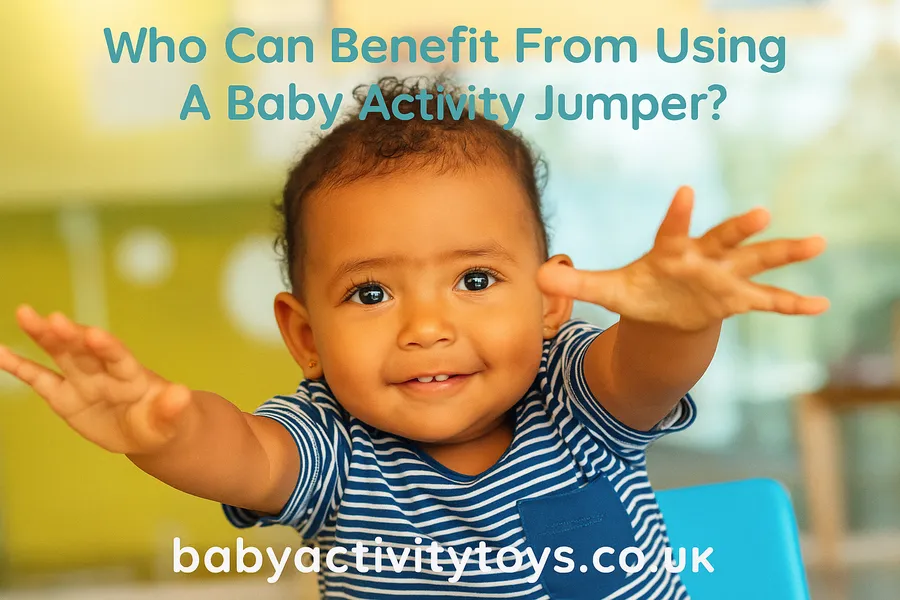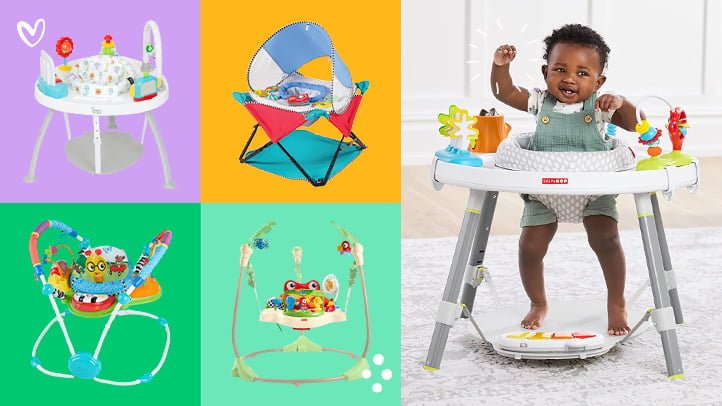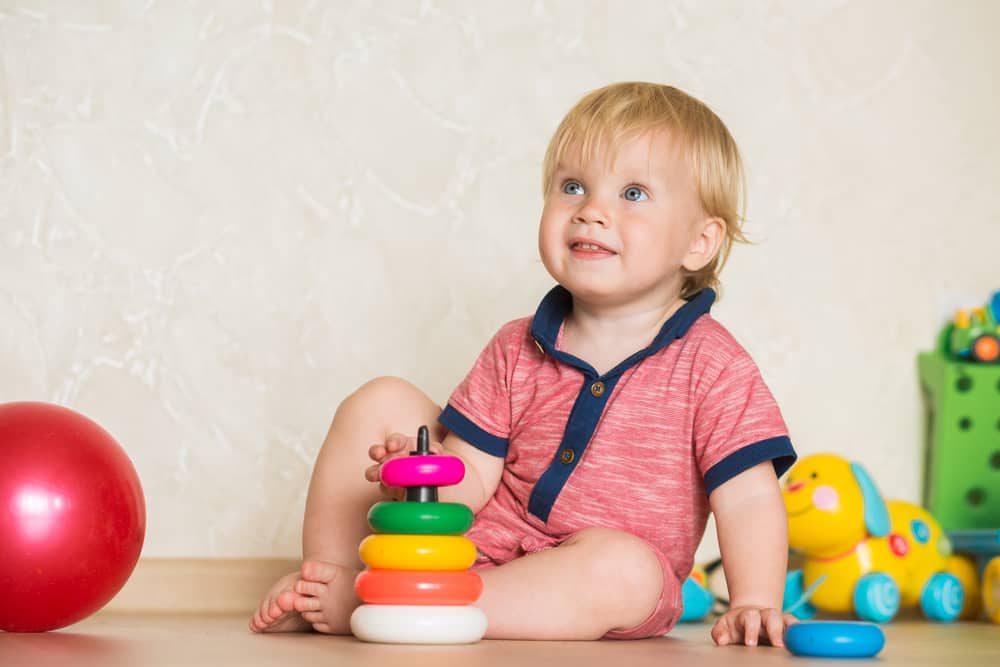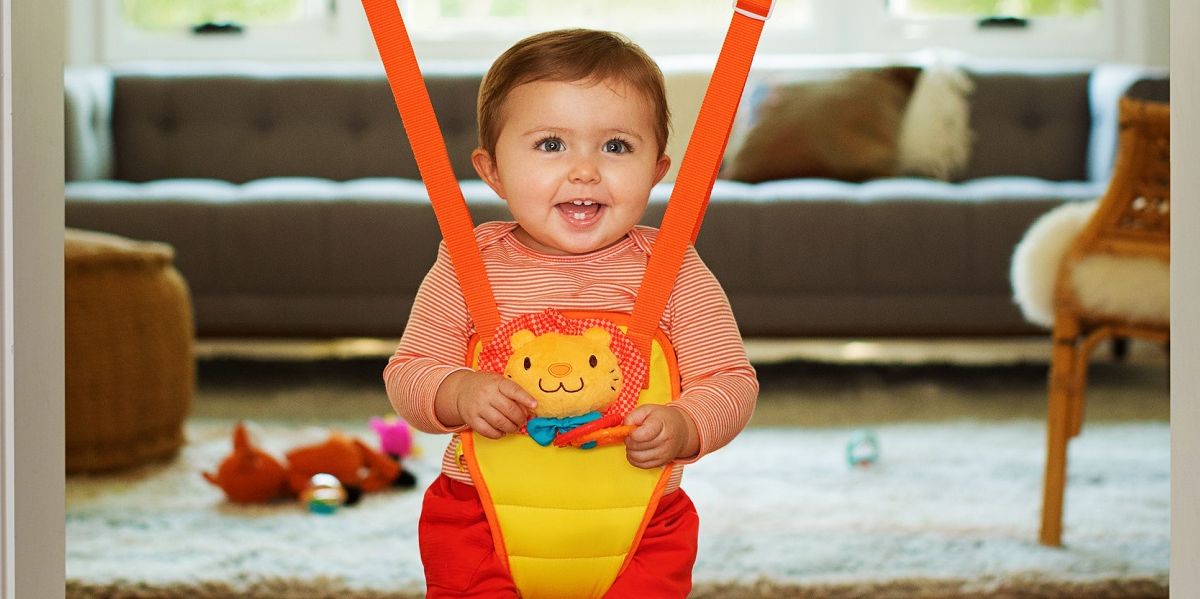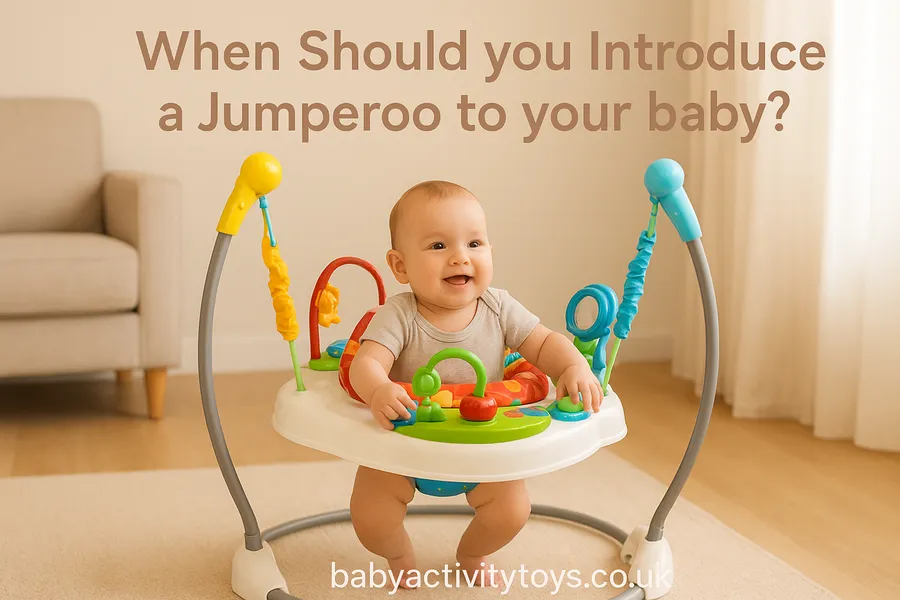
The sight of your baby gleefully bouncing in a jumperoo, giggling with each spring, is enough to melt your heart. These colourful, entertaining contraptions have become a staple in many UK nurseries, promising you a few precious minutes of hands-free time while keeping your little one engaged. But beneath the surface of those happy bounces lies an important question you should consider: are baby jumperoos actually safe, and when is the right time to introduce them?


What Exactly Is a Baby Jumperoo?
Before diving into safety considerations, let’s establish what we’re talking about. A baby jumperoo is a stationary activity centre featuring a seat suspended by elastic straps or springs within a sturdy frame. Unlike door-mounted jumpers that hang from doorframes, jumperoos are freestanding units that typically include:
- A rotating seat allowing 360-degree spinning
- An array of toys, lights, and sounds attached to a circular tray
- Adjustable height settings to accommodate your growing baby
- Sturdy frame legs for stability
The concept is simple: your baby uses their legs to push off from the floor, creating a bouncing motion that most find absolutely delightful. The entertainment value is undeniable, and many parents consider jumperoos essential baby gear for those challenging months when infants are too active to sit still but not yet mobile enough to explore independently.
The Safety Question: What Do Experts Say?
When it comes to baby jumperoos, the safety conversation is more nuanced than a simple yes or no answer. Paediatricians and child development specialists generally agree that when used correctly and in moderation, jumperoos can be safe. However, the emphasis here is firmly on “correctly” and “in moderation.”
The primary safety concerns surrounding jumperoos centre on developmental impact rather than immediate physical danger. Unlike some baby products that pose clear hazards, jumperoos occupy a grey area where improper or excessive use may potentially affect your baby’s natural developmental progression.
Key Safety Concerns at a Glance
| Concern Type | Potential Issues | What You Should Know |
|---|---|---|
| Developmental Impact | May delay gross motor milestones; time away from floor play | Excessive use could affect natural movement progression |
| Postural Issues | Poor posture; slumping; leaning to one side | Babies need adequate core strength before use |
| Toe-Walking | Encourages pushing off on toes rather than flat feet | Can potentially lead to toe-walking habits |
| Hip & Spine Stress | Unnatural positioning for extended periods | Particularly concerning for babies with existing issues |
| Physical Hazards | Tipping; finger pinching; falls | Usually occurs with improper use or setup |
Developmental Concerns Explained
The most significant concern among paediatric physiotherapists involves the impact on natural movement patterns and muscle development. When your baby spends time in a jumperoo, they’re placed in a position that doesn’t occur naturally in their developmental journey.
Here’s what concerns experts most:
- Your baby’s feet are touching the ground and bearing weight before their body is developmentally ready for standing
- They’re moving in an up-and-down motion that differs from the complex movements they’d be practising during floor time
- Time spent in a jumperoo is time not spent on foundational skills like rolling, sitting, and crawling
- Each natural developmental stage builds specific muscles and neural pathways needed for the next
Some experts worry that excessive jumperoo use might delay gross motor milestones, though research on this topic remains limited.
Postural and Alignment Issues
Another concern involves positioning. Many babies don’t have the core strength to maintain proper posture in a jumperoo, which can lead to:
- Slumping or leaning to one side
- Pushing off on toes rather than using the whole foot
- Stress on hip joints and spine
- Potential development of toe-walking habits when beginning to stand independently
While occasional use is unlikely to cause problems in healthy babies, extended or frequent sessions could potentially contribute to developmental concerns.
Physical Safety Hazards
Beyond developmental concerns, there are practical safety considerations you should be aware of:
- Tipping risk – Your baby can tip jumperoos if they reach too far for toys
- Finger pinching – Spring mechanisms can pose pinching hazards (though modern designs have largely addressed this)
- Falls – The most serious injuries typically occur when jumperoos are used improperly, such as placing them on elevated surfaces
- Weight limit breaches – Using beyond manufacturer recommendations increases accident risk
When Should You Introduce a Jumperoo?
The timing of jumperoo introduction is crucial for both safety and developmental appropriateness. Manufacturers typically recommend starting when babies can hold their heads up steadily and have good trunk control, usually around four to six months old. However, these age ranges are broad generalisations, and your individual baby’s development matters more than any specific age.
Signs Your Baby Is Ready
Rather than focusing on age alone, look for these developmental milestones:
| Readiness Sign | What to Look For | Why It Matters |
|---|---|---|
| Strong Head Control | No wobbling or flopping when upright | Prevents neck strain and ensures safety |
| Trunk Stability | Can sit with minimal support without constant slumping | Indicates core strength for proper posture |
| Leg Weight-Bearing Interest | Actively pushes down with feet when held in standing position | Shows readiness for bouncing motion |
| Proper Foot Positioning | Feet can touch floor flat when seated in jumperoo | Essential for safety and avoiding toe-walking |
Important criteria you shouldn’t overlook:
- Your baby should demonstrate strong, steady head control without any wobbling or flopping (usually develops around four months but can vary)
- They should show emerging trunk stability, meaning they can sit with minimal support
- Your baby should show interest in bearing weight on their legs when you hold them in a standing position
- Your baby’s feet should be able to touch the floor flat when seated in the jumperoo at its lowest setting
If you need to adjust the seat to its lowest position and their feet still can’t reach properly, they’re not ready yet. Proper foot positioning is essential for both safety and avoiding toe-walking patterns.
When to Stop Using a Jumperoo
Knowing when to retire the jumperoo is just as important as knowing when to introduce it.
You should stop using a jumperoo when:
- Your baby reaches the weight limit (typically between 11-13kg or 25-30 pounds)
- Your baby begins crawling confidently
- Your baby starts pulling themselves up to stand
- Your baby shows frustration or tries to climb out
- Your baby reaches approximately 9-12 months old
Many experts suggest stopping earlier, once your baby starts crawling confidently. Once babies become mobile, their developmental priorities shift entirely to practising these new movement skills. Confining a crawling baby to a jumperoo can be frustrating for them and takes away valuable practice time for skills they’re actively working to master.
Safe Jumperoo Practices: Your Comprehensive Guide
If you decide to incorporate a jumperoo into your baby’s routine, following safety guidelines is non-negotiable. These practices can minimise risks and ensure your baby gets the most benefit from their bouncing sessions.
Setup and Environment Checklist
Before each use, ensure you:
- Place the jumperoo on a flat, level surface with no obstructions nearby
- Avoid placing on thick carpets that might affect stability
- Keep away from doorways, stairs, furniture edges, and anything your baby could push off from
- Ensure adequate space around the jumperoo (at least 60cm clearance on all sides)
- Position away from curtain cords, electrical cables, or other hazards
Pre-Use Safety Inspection
| Check Area | What to Inspect | Action Required |
|---|---|---|
| Springs/Elastic Straps | Intact and securely attached | Replace if showing wear or damage |
| Toys & Attachments | Firmly connected with no loose parts | Tighten or remove loose items |
| Seat Fabric | No tears, fraying, or weak spots | Replace if damaged |
| Frame & Legs | Stable without wobbling; all screws tight | Tighten all connections |
| Manufacturer Label | Weight limit and age recommendations visible | Ensure you’re within guidelines |
Time Limits and Supervision Guidelines
The NHS and paediatric physiotherapists suggest you should be mindful of time limits:
Recommended usage:
- Maximum session length: 15-20 minutes
- Maximum daily frequency: Twice per day
- Total daily time: No more than 30-40 minutes
- Priority rule: Jumperoo time should never replace tummy time or floor play
Your supervision responsibilities:
- Never leave your baby unattended, even for a moment
- Stay within arm’s reach at all times
- Watch for signs of fatigue, discomfort, or overstimulation
- End sessions at the first sign of fussiness or frustration
- Think of jumperoo time as an interactive activity, not a babysitter
Proper Positioning Guide
Getting the positioning right is crucial for your baby’s safety and development:
- Adjust seat height so your baby’s feet rest flat on the floor with knees slightly bent
- Check leg positioning – legs should be able to straighten when pushing down but shouldn’t be stretched to reach the ground
- Monitor posture – your baby should maintain a relatively upright position without excessive slumping
- Watch for leaning – if your baby consistently leans to one side, they may not have enough core strength yet
Signs to End the Session Immediately
You should remove your baby from the jumperoo straight away if you notice:
- Fussiness, crying, or attempts to climb out
- Significant slumping or inability to maintain upright posture
- Consistent leaning to one side
- Signs of tiredness (eye rubbing, yawning, decreased activity)
- Overstimulation (excessive crying, arching back, turning away from stimuli)
- Any signs of discomfort or distress
Balancing Benefits and Risks
Despite the concerns, jumperoos do offer some benefits when you use them appropriately. Understanding both sides helps you make an informed decision.
Potential Benefits When Used Correctly
| Benefit Category | What Your Baby Gains | Your Benefit |
|---|---|---|
| Entertainment | Engagement and happiness | Brief hands-free time for essential tasks |
| Sensory Stimulation | Various textures, colours, sounds, movements | Calm, organized baby through vestibular input |
| Fine Motor Skills | Reaching, grasping, hand-eye coordination | Supporting developmental milestones |
| New Perspective | Upright view of environment | Enhanced cognitive development and spatial awareness |
| Physical Activity | Leg strengthening through bouncing | Energy release for active babies |
The Key to Success: Moderation
The secret to maximising benefits whilst minimising risks is straightforward:
- Use jumperoos as one small part of a varied activity routine
- Prioritise floor time – this should always be your baby’s primary activity
- Treat jumperoos as an occasional tool rather than a daily staple
- Stay flexible about discontinuing use if you notice concerning patterns
- Listen to your baby – they’ll tell you what they enjoy and when they’ve had enough
Alternatives and Complementary Activities
Even if you use a jumperoo, it shouldn’t be your only approach to entertaining and engaging your baby. You should provide a well-rounded developmental routine with plenty of alternatives.
Essential Developmental Activities
Tummy Time (Priority #1):
- The gold standard for infant development
- Builds neck, back, shoulder, and core muscles
- Aim for multiple short sessions throughout the day
- Gradually increase duration as your baby’s tolerance grows
- Place interesting toys just out of reach to encourage reaching and eventual crawling
Supported Sitting:
- Gives your baby practice with balance and trunk control
- Sit with your baby between your legs or surround them with pillows
- Allows them to work on maintaining upright position
- Provides freedom to reach and play
- No positioning concerns unlike jumperoos
Baby-Wearing:
- Offers many benefits parents seek from jumperoos
- Your baby gets an upright view of the world
- Exposure to natural movement whilst staying close to you
- Varied positions support healthy development
- Strengthens parent-baby bond
Simple Floor Play:
- The most valuable developmental activity
- Babies learn to roll, reach, pivot, and eventually crawl
- Self-directed movements build strength and coordination
- Develops problem-solving skills
- Cannot be replicated by contained equipment
Daily Activity Balance Guide
| Activity Type | Recommended Daily Time | Developmental Priority |
|---|---|---|
| Tummy Time | 60-90 minutes (spread throughout day) | Essential – Highest priority |
| Floor Play | 2-3 hours of unrestricted movement | Essential – Highest priority |
| Supported Sitting | 20-30 minutes (several short sessions) | Important – High priority |
| Baby-Wearing | As desired for bonding and outings | Beneficial – Medium priority |
| Jumperoo | Maximum 15-20 minutes, twice daily | Optional – Lowest priority |
Making an Informed Decision for Your Family
Ultimately, the decision to use a jumperoo is personal and depends on your individual circumstances, your baby’s needs, and your parenting philosophy. There’s no universally right or wrong answer, but there is a right answer for your family.
If You Decide to Use a Jumperoo
Your action plan should include:
- Staying informed about potential concerns
- Following all safety guidelines without exception
- Strictly limiting session duration (15-20 minutes maximum)
- Prioritising floor time and other developmentally important activities
- Using the jumperoo as an occasional tool rather than daily staple
- Remaining flexible about discontinuing use if concerns arise
- Monitoring your baby’s developmental progress with your health visitor
If You Choose Not to Use a Jumperoo
You should know that:
- Many babies develop beautifully without ever experiencing one
- The money saved can be invested in other baby gear or activities
- Your baby won’t miss what they’ve never had
- Floor time and natural movement provide everything they need
- Your instincts about what works for your family are valid
Questions to Ask Yourself
Before making your decision, consider:
- Does your baby seem to enjoy bouncing movements?
- Do you have adequate space for safe jumperoo setup?
- Can you commit to strict time limits and constant supervision?
- Are you prioritising floor time as the foundation of your baby’s day?
- Does your baby have any developmental concerns that might warrant avoiding jumperoos?
- What does your health visitor or GP say about your specific situation?
Working with Healthcare Professionals
Regardless of your decision, you should maintain open communication with your health visitor and GP, especially if you have concerns about your baby’s development.
When to seek professional guidance:
- Before introducing a jumperoo if your baby was premature or has any developmental delays
- If you notice your baby isn’t meeting expected milestones
- If your baby develops unusual movement patterns (like persistent toe-walking)
- If your baby shows signs of hip or spine issues
- If you have any concerns about your baby’s posture or strength
Your healthcare team can assess whether your baby is meeting appropriate milestones and provide personalised guidance based on your child’s individual needs.
The Bottom Line: Your Key Takeaways
Baby jumperoos can be safe when you use them correctly, start at the appropriate developmental stage, and limit them to short, supervised sessions.
Remember these critical points:
✓ Start when ready: Your baby needs strong head control, emerging trunk stability, and the ability to bear weight with feet flat
✓ Time limits matter: Maximum 15-20 minutes per session, no more than twice daily
✓ Supervision is non-negotiable: Never leave your baby unattended, even briefly
✓ Floor time comes first: Jumperoo time should never replace tummy time and floor play
✓ Stop at the right time: Discontinue once your baby starts crawling or reaches the weight limit
✓ Listen to your baby: Watch for signs of discomfort, fatigue, or frustration
✓ Quality over quantity: Use mindfully as one small part of a varied routine
Used mindfully as one small part of a varied routine, jumperoos can provide entertainment and brief respites for you without compromising healthy development. Your baby doesn’t need a jumperoo to develop properly, but if you choose to use one responsibly, it’s unlikely to cause harm and might just bring some extra joy to those busy early months of parenthood.
The secret isn’t whether you use a jumperoo but how you use it and what else you’re providing to support your baby’s growth. Trust your instincts, follow the guidelines, and enjoy watching your little one discover the joy of bouncing – in moderation, of course.



